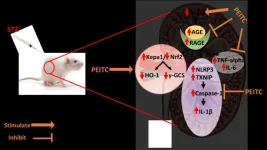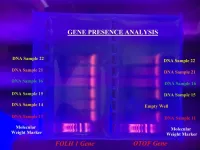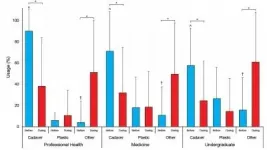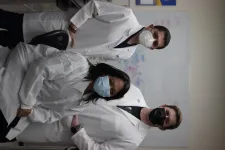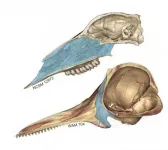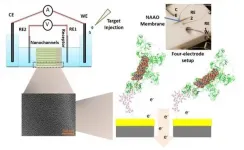Using big data to save babies
Machine learning could detect lung disorder in preemies better than traditional diagnostics
2021-04-27
(Press-News.org) Rockville, Md. (April 27, 2021)--Although bronchopulmonary dysplasia (BPD)--a chronic lung disease affecting newborns--is the most common complication of preterm birth, it remains difficult to diagnose and treat. Researchers from Fundación INFANT in Buenos Aires, Argentina, and The University of Oklahoma Health Sciences Center, hope to address these difficulties using machine learning to inform the clinical care of preemies with BPD. The team will present their work virtually at the American Physiological Society's (APS) annual meeting at Experimental Biology 2021.
BPD affects between 20% and 40% of all infants with birthweight below 3 pounds, 4 ounces (1,500 grams). It usually subsides by age five but can extend into adulthood. Infants with BPD face prolonged hospitalization and are at risk of developmental delays and heart failure.
The research team presented an algorithm with a large data set of longitudinal clinical information for preterm infants, which the computer divided into three clusters. They then presented the trained algorithm with a second data set with comparable demographic characteristics. In this set, the computer was able to anticipate comorbidities and rehospitalizations better than the application of standard BPD diagnostic categories.
By more accurately aligning which biometrics correspond to different degrees of disease severity, these findings could enable better understanding of the underlying causes of BPD. They could also help clinicians diagnose BPD earlier and more precisely, allowing for personalized treatments.
Corresponding author Gaston Ofman, MD, says the next step is "to implement our analysis in real time and guide health care workers in their day-to-day care of preterm babies."
INFORMATION:
NOTE TO JOURNALISTS: To schedule an interview with a member of the research team, or to request the abstract, "Machine learning discovery of lung disease trajectories in premature infants," please contact the APS Communications Office or call 301.634.7314. Find more research highlights in the END
[Attachments] See images for this press release:

ELSE PRESS RELEASES FROM THIS DATE:
2021-04-27
A new study found that non-pungent synthetic analog of capsaicin -- the compound that makes chili peppers hot -- made small cell lung cancer cells more responsive to treatment. Small cell lung cancer is a very aggressive form of cancer with a low survival rate.
Cisplatin-based combination chemotherapy is typically the first-line treatment for small cell lung cancer patients. Although patients initially respond very well to this chemotherapy, the tumor usually comes back within a year in a form that doesn't respond to treatments. Patients with relapsed small cell lung cancer have very few treatment options.
"Irinotecan is the only FDA approved second-line drug for small cell lung cancer, but less than 3% of patients respond to it," said research team leader Piyali Dasgupta, ...
2021-04-27
New research conducted in rats suggests a compound that gives some cruciferous vegetables their pungent taste could help to reverse kidney problems associated with diabetes.
It is estimated that about one-quarter of people with diabetes will eventually develop diabetic nephropathy, a gradual loss of kidney function eventually requiring dialysis. The condition is a leading cause of chronic kidney disease in the U.S. and is also associated with a high risk of heart disease. There is currently no cure.
For the new study, researchers assessed the effects of phenethyl isothiocyanate (PEITC) in rats with diabetic nephropathy. PEITC is found in several types of vegetables but is most concentrated ...
2021-04-27
Corals are part of a highly complex ecosystem, but it remains a mystery if and how they might communicate within their biological community. In a new study, researchers found evidence of sound-related genes in corals, suggesting that the marine invertebrates could use sound to interact with their surroundings.
Coral reefs make up less than 1% of the ocean floor yet support more than 25% of all marine life. Around the world, coral reefs are being threatened by climate change, ocean acidification, diseases, overfishing and pollution. A better understanding of coral communication could help inform policies that aim to protect this critical ecosystem.
"A growing number of studies have shown that trees can communicate, and that this communication is important for ecosystems such ...
2021-04-27
The antidepression drug duloxetine could be beneficial to patients with both depression and cardiovascular disease, according to new studies performed in human blood and in mice. Globally, more than 300 million people have depression, which comes with an increased risk of developing cardiovascular disease.
When a blood vessel is injured, the platelets in our blood respond by forming clots that stop blood bleeding. If this activation goes into overdrive, it can lead to thrombosis, a condition where blood clots form inside blood vessels and can dislodge to lead to a heart attack or stroke. In the new studies, researchers showed that duloxetine inhibited platelet function and protected ...
2021-04-27
Scientists from around the world are gathering to share the latest research at the forefront of biology during the END ...
2021-04-27
Recent years have brought increased attention to the lasting effects of chemicals we unwittingly inhale, touch and ingest while going about our daily lives. The END ...
2021-04-27
Results from a new cell study suggest that the SARS-CoV-2 spike protein can bring about long-term gene expression changes. The findings could help explain why some COVID-19 patients -- referred to as COVID long-haulers -- experience symptoms such as shortness of breath and dizziness long after clearing the infection.
SARS-CoV-2, the virus that causes COVID-19, is covered in tiny spike proteins. During infection, the spike proteins bind with receptors on cells in our body, starting a process that allows the virus to release its genetic material into the inside of the healthy cell.
"We found that exposure to the SARS-CoV-2 spike protein alone was enough to change ...
2021-04-27
The two major types of cetaceans appear to have evolved their characteristic blowholes through different anatomical transformations, according to a study being presented at the END ...
2021-04-27
Findings from a new cell study suggest that the natural plant compound sanguinarine could be a promising tool for targeting triple-negative breast cancer cells. The researchers also found that breast cancer cells derived from people with African American ancestry were more sensitive to sanguinarine than those of European origin.
"Triple negative breast cancer is especially aggressive in African American women, who are also more likely to develop this type of breast cancer than women of European descent," said Samia Messeha, PhD, a research associate in the College of Pharmacy and Pharmaceutical Science at Florida Agricultural and Mechanical ...
2021-04-27
Researchers are developing a new sensor that can detect Ebola in a single drop of blood and provides results in just an hour. With further development, the technology might also enable fast and inexpensive detection of other viruses, including the virus that causes COVID-19.
Ebola is one of the deadliest of all known viruses, killing up to 90% of those infected. Stopping its spread requires quickly detecting and isolating infected people. However, outbreaks tend to occur in remote areas of Africa, requiring blood tests to be transported to distant laboratories for analysis. This leads to significant delays in identifying a new outbreak.
Soma Banerjee, PhD, a visiting scientist in Marit Nilsen-Hamilton's laboratory at Iowa State ...
LAST 30 PRESS RELEASES:
[Press-News.org] Using big data to save babies
Machine learning could detect lung disorder in preemies better than traditional diagnostics

